 |

State of Alaska > DOLWD > Alaska
Economic Trends
2005 Alaska Economic Trends
Alaska Economic Trends are searchable from 1978 to the present using the Trends search page. The search can include any combination of the title or subtitle, date or date range, author, or full text.
|
| December 2005 |
The Mat-Su Borough |
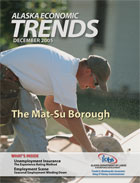 |
The Matanuska-Susitna
Borough’s
economic indicators all tell the same story: They describe the
fastest growing area in the state. Growth measures including employment,
population, business formation, in-migration, highway counts and
new homes being built all point to the Mat-Su Borough. In fact,
it’s the only area in the state where the term “booming” is
applicable.
December 2005 Trends |
| |
|
| November 2005 |
Alaska: An Interesting
Income Picture |
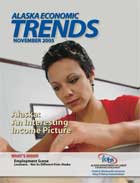 |
Alaskans earned a combined $22.6
billion in 2004, an increase of slightly more than $1 billion from
2003, according to the most recent income data for the state. Dividing
that number by the number of residents – every man, woman
and child – means that Alaska’s per capita income was
$34,454. That’s an impressive figure, but it only takes on
real meaning when compared to other states or when observed in
a historical context. And this particular income figure is only
one measure among many calculations of income.
November 2005 Trends |
| |
|
| October 2005 |
Workers with Disabilities |
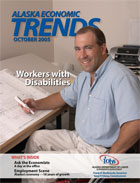 |
The U.S. Census Bureau estimates
that
86,000 Alaskans age 5 and over – 15
percent of Alaska’s population – have
a disability. Of those, 58,000 are of
working age, 16 to 64, according to its 2003
American Community Survey.
October 2005 Trends |
| |
|
| September 2005 |
Alaska's Information Industry |
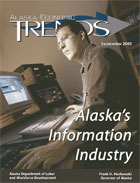 |
Although Alaska’s information industry is
small – it employs only 2 percent of the state’s wage
and salary work force – it is the third-highest paying industry
in the state, behind only natural resources/ mining and construction.
It is also one of the most dynamic. Technological changes, market
conditions and the relatively recent deregulation of the telecommunications
industry have transformed the landscape for most information sector
employers. And more changes are likely.
September 2005 Trends |
| |
|
| August 2005 |
Eilson AFB -
Base Realignment and Closure |
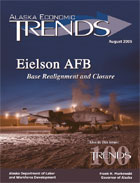 |
In May 2005 the Department of Defense
recommended to the Base Realignment and Closure Commission (BRAC)
the virtual closure of Eielson Air Force Base, located 26 miles
southeast of Fairbanks. The Defense Department recommended the
withdrawal of 2,821 uniformed personnel and a transfer of the aircraft
inventory of the 354th Fighter Wing to Nevada, Georgia and Louisiana.
According to military sources, high operational and infrastructure
costs put Eielson AFB on their realignment list. The base has a
more than 60-year presence in the Fairbanks area and has been a
solid foundation in the local economy.
August 2005 Trends |
| |
|
| July 2005 |
The Cost of Living in Alaska |
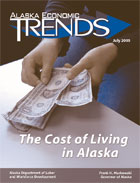 |
The high cost of living in Alaska
is part of the state’s folklore, but the stories are based
on economic reality. In the state’s early days, transportation
costs and a limited ability to produce goods locally led to exorbitant
prices for everything from housing to basic grocery items. As the
state’s population grew and infrastructure developed, costs
moderated substantially but remained signifi cantly higher than
the national average.
July 2005 Trends
|
| |
|
| June 2005 |
Wage Records |
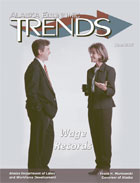 |
If each of Alaska’s workers
was employed in one job continuously throughout his working life,
then the task of understanding the labor market would be simple.
However, we all know the labor market is much more fluid. Workers
are hired and separate from jobs continuously throughout the
year. Some workers are employed in multiple jobs consecutively
or concurrently
over time. Some work only seasonally, and some come from other
parts of the country and from around the world to work in Alaska.
June 2005 Trends
|
| |
|
| May 2005 |
Employment Forecast
2005-2006 |
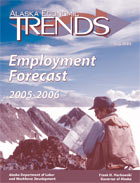 |
Alaska has recorded a net job increase every year
since 1988, an impressive streak that reached seventeen years
in 2004. Given the inertia of such long-running, consistent growth,
a shift in direction is unlikely, absent a significant shock to
one of the fundamental drivers of the state’s economy. Growth
of 1.5 percent is forecast for 2005, followed by 1.4 percent in
2006.
May 2005 Trends
|
| |
|
| April 2005 |
The Year 2004
in Review |
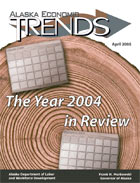 |
The streak goes on. For the seventeenth consecutive
year Alaska added jobs to its economy in 2004. The year’s
average monthly job count of 304,000 was an increase of 4,700
over 2003 and marked the first time the state climbed above the
300,000 mark. A historical look shows Alaska surpassed 200,000
jobs in 1982 and 100,000 in 1972. Only three other states, all
in the sun belt, can claim to have at least tripled their job
count since 1972: Nevada, Arizona, and Florida.
April 2005 Trends |
| |
|
| March 2005 |
The Northern
Region |
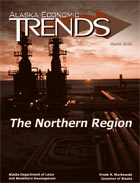 |
A laska’s Northern Region covers more than
146 thousand square miles or approximately a quarter of all the
land area of Alaska. This huge piece of real estate contains only
24,000 individuals, or less than four percent of the state’s
population. Its inventory of natural resources includes the nation’s
largest oil fields, a resource that has generated more wealth
for the state than any other single source. It was the site of
the state’s largest gold rush, and currently is home to
the world’s largest zinc mine. Geographically, it includes
the North Slope and Northwest Arctic Boroughs and the Nome Census
Area with a total of 35 communities. Only three of these communities
have more than a thousand residents.
March 2005 Trends |
| |
|
| February 2005 |
Projections for
Alaska population 2005–2029 |
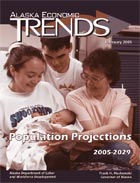 |
Resources, historical events, and human desire
have combined to shape the population of Alaska. Historic demographic
trends do create a reality that guides future events. However,
there is no crystal ball that allows us to foretell the future.
While the recent past is our best guide to the future, things
never turn out quite as predicted. The large “baby boom”
population that has dominated demographics for the last 30 years
is a force that will continue to influence Alaska’s future.
February 2005 Trends |
| |
|
| January
2005 |
Transportation |
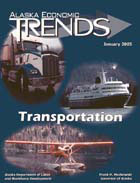 |
Nearly 19,000 wage and salary employees work in
Alaska’s private sector transportation and warehousing industry.
This is more than construction, oil, information, and a number
of other industries. Fourteen of the state’s top 100 private
sector employers are involved in transportation. The industry
generates more than $3.3 billion in annual revenues. Public sector
transportation is also important and includes the high profile
Alaska Marine Highway and Alaska Railroad. Impressive as these
facts may be, the real value of transportation lies in its contributions
to the rest of the economy. Transportation weaves the web that
ties Alaska’s economy together and binds it to the world.
January 2005 Trends |
Return to Top of Page
|















